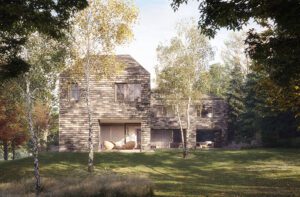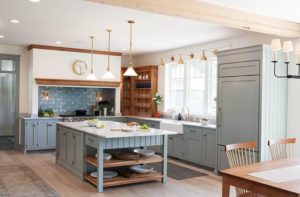Modern on Mason’s Island
July 6, 2017
A shingled cottage on a Connecticut island is a winning combination of classic and modern.
Text by Maria LaPiana Photography by Warren Jagger
James Estes and Peter Twombly wrote the book on Yankee Modern (well, technically it was written about them), a movement celebrating “simple, innovative designs with firm roots in the New England tradition.” The Newport, Rhode Island-based architects believe that logical and direct solutions, the use of traditional materials and methods, and thoughtful siting inevitably result in good design. This home is a classic example.
Described by the homeowner as “a three-winged ranch,” it was designed by Estes to sit on a long, narrow waterfront acre on tiny Mason’s Island, just off the coast of Mystic, Connecticut. Although clearly inspired by iconic New England architecture, with its cladding of white cedar shingles, standing-seam metal roof, and gray-stained cedar trim, the home is distinctly modern.
Members of the island’s close-knit community since the early 1990s, the clients wanted to replace their 1950s cottage with a casual home that would be low-maintenance and high-quality. Building on the good bones of a simple and balanced design, Estes insisted on the highest-quality materials and craftsmanship, and that was fine with builder Steve Ray, who notes that it’s the details that make the difference. “The home was very interesting to build, and challenging—in a good way,” he says.
The unusual site with abundant views (and strict coastal regulations) gave the home its structure, informing the footprint, which at 3,000 square feet is relatively small. Three single-story, gabled buildings are organized in a kind of splayed “U” with glass connectors. There’s an entry court on the street side, while rooms in the bottom leg of the “U” enjoy the best views. This wing houses the kitchen/living area and the master suite, and can serve as a self-contained home. The second wing holds three bedrooms, and the third wing serves as a utility space that includes the garage and exercise room.
The team used advanced framing techniques to save lumber and installed an HRV system to keep heat in while moving stale air out. Each wing has its own heating and cooling zone, but the most energy-efficient feature of the house may well be its comparatively small size, says Estes.
A clean-lined interior with built-ins, including benches and shelves with cantilevered tops, gives the house the beauty and functionality of a luxury yacht. A light palette of interior materials throughout includes maple floors and cabinets, and natural pine windows and doors. White ceilings both high and low float above the sugar pine walls and trim.
This a home designed for getting away—and getting together. The kitchen has an island so wide the wife says she can’t reach across it. The dining table (one piece of very heavy wood) can seat twelve people. The living and dining areas open to the deck to expand the space, contributing to the indoor/outdoor connection.
Landscape architect Anne Penniman was charged with creating what she calls “a minimal, no fuss landscape,” using native stone for walls, paths, and curbs. “The crisp, designed lines of the hardscape give way to the softer, more natural lines of meadow, shrubs, and eventually the tidal wetland at the water’s edge,” she explains.
At a turning point in the project, she says, “the owners decided to embrace the natural beauty of their spectacular coastal grassland landscape, understanding that it would make a perfect pollinator habitat.” So Penniman used native plant communities—from shrubs and grasses to attractive perennials—to create a pollinator-friendly landscape. It’s a multi-year project in its infancy, but the owners plan to expand it further along the coastline.
The homeowners agree that Penniman’s landscape design, Estes’s “quiet Yankee” style, and Ray’s penchant for precision were a perfect match for their vision. The wife says they absolutely love their “minimalist, lean, and clean” home—as well as the enchanting views that drew them to the island from the start: “the morning sun, the beautiful shine onto the water from the setting sun, and the rising moon, which always makes us think of a giant penny ascending above the skyline.”
The house is a study in simplicity—and problem solving. It was a tough site, says architect Jim Estes: “Not much room and close neighbors.” To make the most of the lot, he took the house up to the setback lines, which created a courtyard on the street side.
Share
![NEH-Logo_Black[1] NEH-Logo_Black[1]](https://www.nehomemag.com/wp-content/uploads/2022/08/NEH-Logo_Black1-300x162.jpg)

















You must be logged in to post a comment.